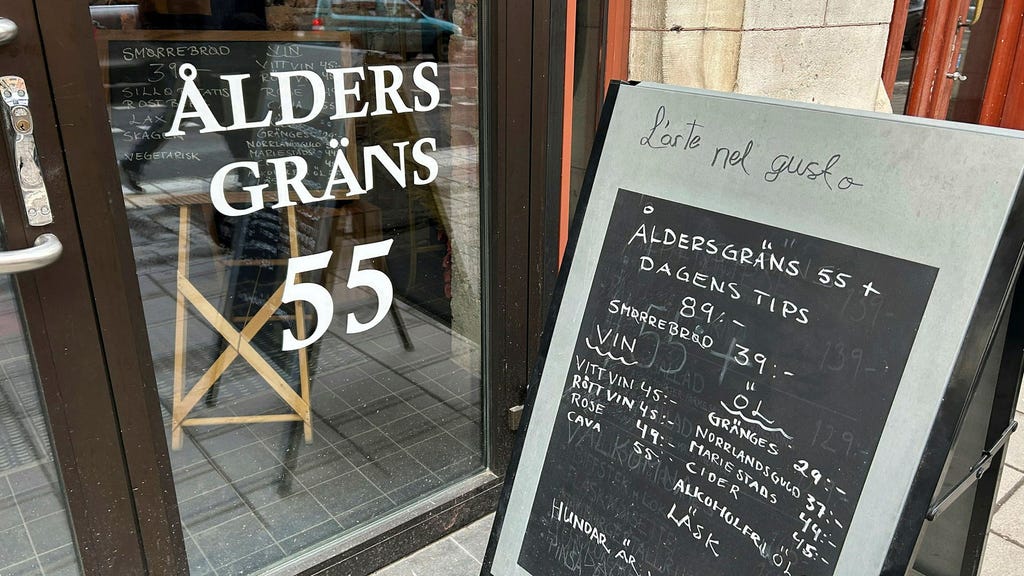The author, aged 54, humorously recounts her anxiety-ridden experience attempting to enter a newly popular Stockholm pub, exclusively catering to the 55-plus crowd. The establishment, a down-to-earth beer café in the Södermalm district, had garnered significant attention for its age-restrictive policy, attracting hordes of older patrons seeking a welcoming space within the bustling city. The author’s self-deprecating narrative likens her apprehension to the nerve-wracking experience of trying to sneak into a nightclub underage, the memory vividly transporting her back to her teenage years. The perceived risk of being discovered as ”underage” fuels her internal monologue, imagining the pub owner’s discerning gaze capable of instantly exposing her lack of qualifying wrinkles and gray hairs. This act of playfully “wallraff”-ing, a term referring to undercover investigative journalism, transforms a mundane Thursday into an amusing adventure, injecting a sense of youthful rebellion into the otherwise ordinary act of visiting a pub.
The author’s internal struggle continues as she waits in line, clutching her identification card with clammy hands, anticipating the inevitable interrogation regarding her age. The media hype surrounding the pub’s strict adherence to its age policy only amplified her nervousness. Anecdotes of the owner’s rigorous identification checks and a patron’s preemptive phone call confirming her three-year-old dog’s admittance add to the author’s apprehension. The author humorously notes the irony of worrying about a dog’s age appropriateness while she herself attempts to pass as older than she is. This juxtaposition highlights the absurdity of the situation and further underscores the author’s self-conscious preoccupation with meeting the pub’s age requirement. The anticipation builds, painting a comical picture of the lengths people go to for belonging and the perceived exclusivity of this particular establishment.
Much to the author’s surprise, the anticipated interrogation never occurs. Instead of demanding proof of age, the pub owner simply asks for her order. Relieved and slightly disoriented by the unexpected ease of entry, the author hurriedly scans the menu, settling on an affordable combination of a salmon open-faced sandwich and bottled beer. The establishment’s appeal, beyond its age demographic, lies in its budget-friendly prices, a stark contrast to the owner’s previous unsuccessful venture, a high-end Italian deli. This shift in strategy proves incredibly successful, as evidenced by the bustling atmosphere and packed tables, indicating a strong demand for affordable dining and socializing options among the 55-plus demographic.
The author paints a vivid picture of the pub’s warm and convivial atmosphere, noting the absence of laptops and mobile phones, a refreshing change in the age of digital distraction. The packed tables and shared spaces foster a sense of community, where striking up conversations with fellow patrons feels completely natural. This observation underscores the pub’s success in creating a welcoming and engaging environment specifically tailored to its target audience. The absence of technology further enhances the social experience, encouraging genuine interaction and fostering a sense of connection among patrons. The author’s experience suggests a deeper societal need for spaces where people can disconnect from the digital world and engage in face-to-face interaction.
The popularity of the establishment clearly surpasses the owner’s initial expectations, leading to a search for additional staff to handle the overwhelming demand. The author and her fellow diners speculate that this pub signifies the beginning of a trend, envisioning a surge of similar age-restricted establishments catering to the often-overlooked demographic of older adults. This prediction reflects a growing awareness of the need for age-inclusive spaces in the hospitality industry, recognizing the desires and needs of a demographic that often feels marginalized in the typical bar and restaurant scene. The success of this pub suggests a potential market for businesses that cater specifically to the social and dining preferences of older adults.
The author concludes her narrative with a reflection on her experience, expressing a newfound appreciation for the unexpected joys of pretending to be older. The sense of belonging and the lively atmosphere of the pub outweigh the initial anxiety of potentially being exposed. The experience transforms a routine Thursday into a memorable occasion, leaving the author feeling more alive and connected. This concluding sentiment emphasizes the importance of social connection and finding spaces where individuals feel welcomed and valued, regardless of age. The author’s willingness to playfully embrace the charade of being older highlights the human desire for community and the positive impact that inclusive spaces can have on individual well-being.














